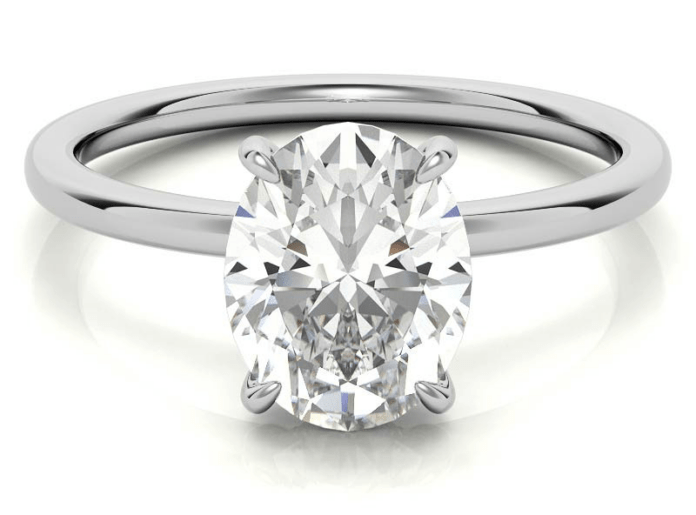
A lab-grown diamond is just the same as a mined one, but up to this day, there are still misconceptions about the former. Not only does it offer the same chemical, physical, and optical properties as natural diamonds, but it is also up to 50% cheaper than them. This means you can get a bigger lab-grown diamond with great quality for the same price as a smaller mined diamond. Nonetheless, there are other things you need to know before you make that lab-grown diamond ring purchase.
Lab-grown Diamond Vs. Mined Diamond Rings
The debate between lab-grown diamonds and mined diamonds continues to persist these days. As such, it is unsurprising that there’s a stigma about the former, especially when it comes to its quality. However, lab-grown diamonds have long been recognized as genuine diamonds by regulating bodies like the Federal Trade Commission (starting in 2018) and nonprofit research institutes like the Gemological Institute of America.
Unlike other beliefs, lab diamonds share the same molecular structure as mined diamonds. This similarity goes down to both the diamonds’ elemental carbon in a diamond cubic, making them indistinguishable from one another.
The main difference between the two is how they are produced, with lab diamonds being created in environment-controlled facilities by either using Chemical Vapor Deposition or High-Pressure High-Temperature processes. Through this, lab diamonds can be produced within months, making them more affordable than the mined variants.
Lab Diamond: Is it better?
In terms of quality and properties, lab and mined diamonds are the same. Even lab diamonds can offer different grades, and a perfectly cut, internally flawless diamond can also be produced inside a lab. However, in terms of pricing, lab-grown diamonds offer the best value, as you could purchase a high-carat piece without breaking the bank.
This makes it an interesting option for diamond ring buyers, allowing them to purchase high-carat diamonds with good clarity and color at a more reasonable price. As mentioned before, lab diamonds can be 30% to 50% cheaper than mined diamonds. Comparing the current pricing of mined diamonds to lab diamonds today, you can get a high-quality lab diamond for the price of a low-quality mined one.
Selecting Your Lab Diamond Ring
Despite being more affordable, lab diamonds vary in different aspects. With this, you also need to consider various points when choosing the right one for your ring. To start, just like in mine diamonds, you have to consider the four important Cs in diamond purchase: cut, color, clarity, and carat.
These points, however, depend on your personal preference, as opting for higher qualities (e.g., higher carat, better color range, etc.) could also affect the price of the diamond. Thankfully, it is possible to tick all these boxes in lab diamonds without spending as much as you would when buying a mined diamond.
When choosing the cut of the diamond, you might encounter a wide variety of shapes, with the round option being the most common. Yet, there are also other options out there, including cushion cut, princess, oval, emerald, and more. The main objective here is to find the shape that fits your preference, but note that the shape is directly related to carat weight.
As expected, the higher the carat, the pricier the diamond will be. In the US, the average carat weight of a diamond is between 1.08 and 1.2 carats. Some buyers opt for weights lower than the average (e.g., 0.8ct or 0.9ct), with the small weight reduction being barely noticeable to the naked eye. However, this is almost unnecessary in lab diamonds, as they are still comparably more affordable than mined diamonds, even in high-carat options.
Also, consider the cut of the diamond in your ring. This is different from the shape of the diamond, as it determines how much light the stone reflects. This gives life and sparkle to the appearance of the diamond, making it vital in your decision-making. Here, we suggest going for diamonds with Ideal or Excellent cuts.
Complementing that point is the color of the diamond, wherein you have to find the diamond that should appear white. As mentioned before, the cut of the diamond can contribute to the color it will show. A colorless diamond usually comes in D or E colors, but you can also go for the G to I color range, as they also give off the same colorless appearance under the naked eye.
Ultimately, make sure that the diamond in your ring doesn’t have inclusions that can be spotted by the naked eye. These blemishes are natural in diamonds, but it is best to get an “eye-clean” stone. The FL and IF grades offer the best clarity in diamonds, but you can also get them within the VS1 to VS2 range.
The challenge in purchasing the right lab-grown diamond ring is not over when you find the perfect diamond. This continues in other sections. One point includes the certification of the stone. Needless to say, even lab diamonds have their own certification, which confirms their genuineness and grades. As such, make sure to go for reliable stores that offer them. Some of the most common certification bodies for diamonds include GIA, AGS, and IGI.
The Perfect Lab-Grown Diamond Ring
To have the perfect lab diamond ring, you must also take into account the setting of the ring. The material that will be used for the setting can affect the color of the diamond, and it could either benefit or bring a disadvantage to the appearance of the stone.
With this, if you have a colorless lab diamond, the white gold and platinum material can be an ideal choice for the setting. The color should help put emphasis on the stone’s colorless appearance, allowing it to stand out and appear more high-grade.
On the other hand, if you have a diamond with a slight yellow tint, which is usually seen in the K to M color grade range, using yellow gold or rose gold material is ideal. Since these metals have darker shades compared to white gold and platinum, they can complement diamonds with poorer color grades. Using them on such diamonds doesn’t cause a huge color difference between the stone and the setting, allowing the stone to retain its original color appearance.








